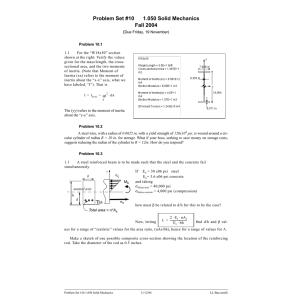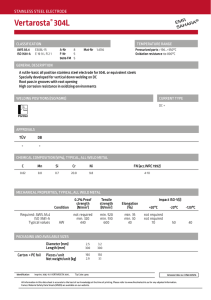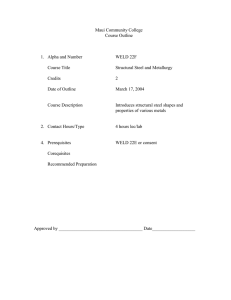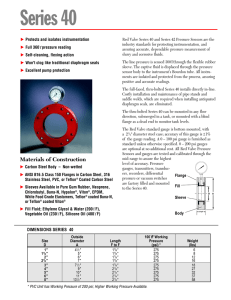welding electrode classifications - Red-D-Arc
advertisement
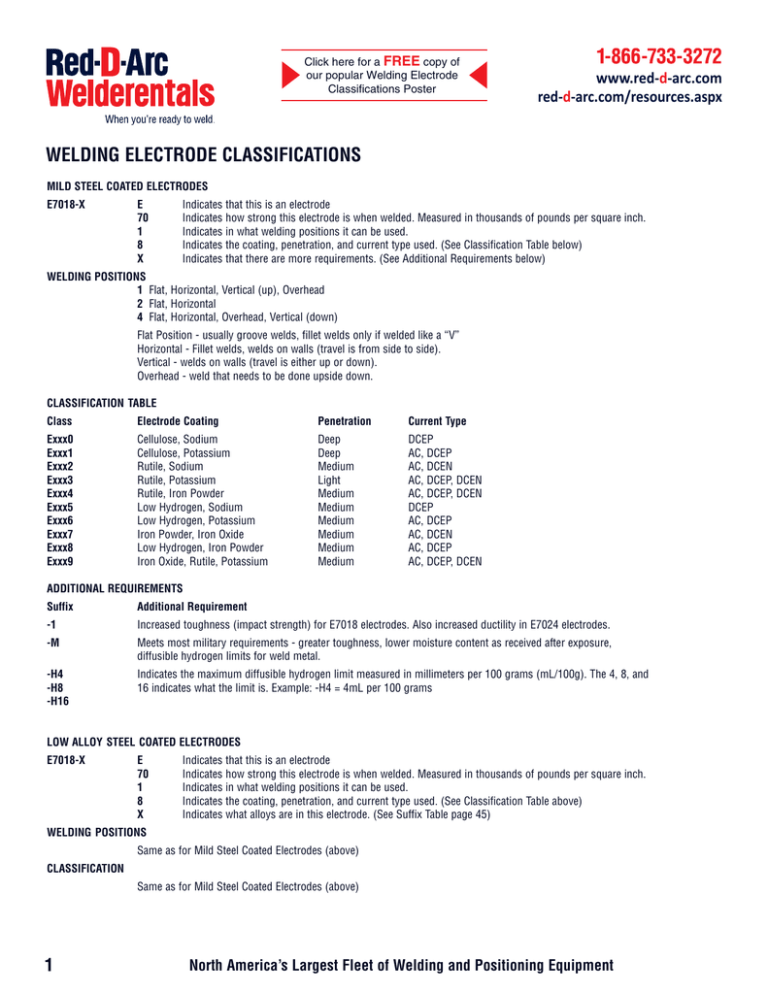
Click here for a FREE copy of our popular Welding Electrode Classifications Poster www.red-d-arc.com red-d-arc.com/resources.aspx WELDING ELECTRODE CLASSIFICATIONS MILD STEEL COATED ELECTRODES E7018-X E 70 1 8 X Indicates that this is an electrode Indicates how strong this electrode is when welded. Measured in thousands of pounds per square inch. Indicates in what welding positions it can be used. Indicates the coating, penetration, and current type used. (See Classification Table below) Indicates that there are more requirements. (See Additional Requirements below) WELDING POSITIONS 1 Flat, Horizontal, Vertical (up), Overhead 2 Flat, Horizontal 4 Flat, Horizontal, Overhead, Vertical (down) Flat Position - usually groove welds, fillet welds only if welded like a “V” Horizontal - Fillet welds, welds on walls (travel is from side to side). Vertical - welds on walls (travel is either up or down). Overhead - weld that needs to be done upside down. CLASSIFICATION TABLE Class Electrode Coating Penetration Current Type Exxx0 Exxx1 Exxx2 Exxx3 Exxx4 Exxx5 Exxx6 Exxx7 Exxx8 Exxx9 Cellulose, Sodium Cellulose, Potassium Rutile, Sodium Rutile, Potassium Rutile, Iron Powder Low Hydrogen, Sodium Low Hydrogen, Potassium Iron Powder, Iron Oxide Low Hydrogen, Iron Powder Iron Oxide, Rutile, Potassium Deep Deep Medium Light Medium Medium Medium Medium Medium Medium DCEP AC, DCEP AC, DCEN AC, DCEP, DCEN AC, DCEP, DCEN DCEP AC, DCEP AC, DCEN AC, DCEP AC, DCEP, DCEN ADDITIONAL REQUIREMENTS Suffix Additional Requirement -1 Increased toughness (impact strength) for E7018 electrodes. Also increased ductility in E7024 electrodes. -M Meets most military requirements - greater toughness, lower moisture content as received after exposure, diffusible hydrogen limits for weld metal. -H4 -H8 -H16 Indicates the maximum diffusible hydrogen limit measured in millimeters per 100 grams (mL/100g). The 4, 8, and 16 indicates what the limit is. Example: -H4 = 4mL per 100 grams LOW ALLOY STEEL COATED ELECTRODES E7018-X E 70 1 8 X Indicates that this is an electrode Indicates how strong this electrode is when welded. Measured in thousands of pounds per square inch. Indicates in what welding positions it can be used. Indicates the coating, penetration, and current type used. (See Classification Table above) Indicates what alloys are in this electrode. (See Suffix Table page 45) WELDING POSITIONS Same as for Mild Steel Coated Electrodes (above) CLASSIFICATION Same as for Mild Steel Coated Electrodes (above) 1 North America’s Largest Fleet of Welding and Positioning Equipment Click here for a FREE copy of our popular Welding Electrode Classifications Poster www.red-d-arc.com red-d-arc.com/resources.aspx WELDING ELECTRODES CLASSIFICATIONS LOW ALLOY STEEL COATED ELECTRODES, CONT’D. SUFFIX TABLE Suffix Steel Alloy Type Suffix Number Description -A1 -B1 -B2 -B2L -B3 -B3L -B4L -B5 -B6 -B8 -C1 -C1L -C2 -C2L -C3 -NM -D1 -D2 -D3 -W -G -M Carbon-Molybdenum Chromium-Molybdenum Chromium-Molybdenum Chromium-Molybdenum Chromium-Molybdenum Chromium-Molybdenum Chromium-Molybdenum Chromium-Molybdenum was E502 was E505 Nickel Steel Nickel Steel Nickel Steel Nickel Steel Nickel Steel Nickel-Molybdenum Manganese-Molybdenum Manganese-Molybdenum Manganese-Molybdenum Weathering Steel Military grade 0.40 - 0.65 Mo 0.40 - 0.65 Cr 1.00 - 1.50 Cr Lower Carbon B2 2.00 - 2.50 Cr Lower Carbon B3 1.75 - 2.25 Cr 0.40 - 0.60 Cr 4.6 - 6.0 Cr 8.0 - 10.5 Cr 2.00 - 2.75 Ni Lower Carbon C1 3.00 - 3.75 Ni Lower Carbon C2 0.80 - 1.10 Ni 0.80 - 1.10 Ni 1.00 - 1.75 Mn 1.65 - 2.00 Mn 1.00 - 1.80 Mn Ni, Cr, Mo, Cu No required chemistry May have more requirements Class Min. Tensile Strength Min. Yield Strength E60xx E70xx E80xx E90xx E100xx E110xx E120xx 62,000 psi 70,000 psi 80,000 psi 90,000 psi 100,000 psi 110,000 psi 120,000 psi 50,000 psi 57,000 psi 67,000 psi 77,000 psi 87,000 psi 95,000 psi 107,000 psi 0.40 - 0.65 Mo 0.40 - 0.65 Mo 0.90 - 1.20 Mo 0.40 - 0.65 Mo 1.00 - 1.25 Mo 0.45 - 0.65 Mo 0.8 - 1.2 Mo 0.40 - 0.65 Mo 0.25 - 0.45 Mo 0.25 - 0.45 Mo 0.40 - 0.65 Mo CHEMICAL SYMBOLS FOR THE ELEMENTS C Mn Si P S Cr Ni Mo B Cu Al Ti N Nb V 2 Carbon Manganese Silicon Phosphorus Sulfur Chromium Nickel Molybdenum Boron Copper Aluminum Titanium Nitrogen Niobium Vanadium Most effective hardening element in steel Hardening element second to carbon Deoxidizer, moderate strengthener Causes cracking if too high Aids in machining - Cracking problems like P Hardness (low) - corrosion resistance (high) Hardening element - better cold toughness Hardenability - high temp tensile - creep strength Very small amounts increase hardness Corrosion resistance (low) - cracking (high) Deoxidizer - improves mechanical properties Removes: Oxygen, S, N, and C Improves strength - lowers toughness Hardness - Improves mechanical properties (formerly Columbium [Cb]) Hardness - Improves mechanical properties North America’s Largest Fleet of Welding and Positioning Equipment
